On the South Coast you can find the most impressive spots on Easter Island. Here are the largest and most impressive monuments as well as the place where it all started. On the foothill of the Ranu Raraku are immense tracks of Moai, as well as the quarry where there are still some statues stuck in the rocks.
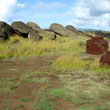 Ahu Vaihú: Ahu Hanga Te’e O Vaihú, platform Te’e situated in Vaihú, is mostly knows as Ahu Vaihú. There are 8 Moai here, face down, with 1 of them completely shattered. The decorated Pukao (head ornament) has even rolled on to close to the coastline. In front of the Ahu is a stone circle, a Paina where the old rituals where held.
Ahu Vaihú: Ahu Hanga Te’e O Vaihú, platform Te’e situated in Vaihú, is mostly knows as Ahu Vaihú. There are 8 Moai here, face down, with 1 of them completely shattered. The decorated Pukao (head ornament) has even rolled on to close to the coastline. In front of the Ahu is a stone circle, a Paina where the old rituals where held.
.
.
.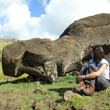 Ahu Akahanga: Exists of multiple Ahu from different building eras with different Moai and decorated Pukao. Ahu Akahanga is also known as the platform of the king, as it is thought that king Hotu Matu’a is burried here. Once, 13 Moai stood on this 18 metre long Ahu, but now only 2 Moai are lying on the beach. The statues vary in height between 5 and 7 metres, 15 to 21 feet.
Ahu Akahanga: Exists of multiple Ahu from different building eras with different Moai and decorated Pukao. Ahu Akahanga is also known as the platform of the king, as it is thought that king Hotu Matu’a is burried here. Once, 13 Moai stood on this 18 metre long Ahu, but now only 2 Moai are lying on the beach. The statues vary in height between 5 and 7 metres, 15 to 21 feet.
.
.
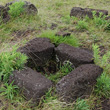 Uma Pae: Near the Akahanga Ahu the clearest remains of a traditional village are found. The Hare Vake or Hare Paenga, as they are known, are boathouses which can clearly be seen. Also, you can see the traditional stone ovens, where volcanic stones where heated until red, and then the food wrapped in leaves was placed upon them to cook.
Uma Pae: Near the Akahanga Ahu the clearest remains of a traditional village are found. The Hare Vake or Hare Paenga, as they are known, are boathouses which can clearly be seen. Also, you can see the traditional stone ovens, where volcanic stones where heated until red, and then the food wrapped in leaves was placed upon them to cook.
.
.
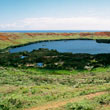 Rano Raraku: Rano Raraku is an extinct volcano, with an oval shaped 600m diameter crater. The sides of the crater go up about 100m and are formed from vulcanic tuff stone. In the middle is a lake, surrounded with totora-reeds and Moai statues, making for a rather surreal landscape.
Rano Raraku: Rano Raraku is an extinct volcano, with an oval shaped 600m diameter crater. The sides of the crater go up about 100m and are formed from vulcanic tuff stone. In the middle is a lake, surrounded with totora-reeds and Moai statues, making for a rather surreal landscape.
.
.
.
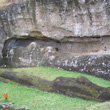 Rano Raraku quarry: The tuff stone sides of the crater made for the ideal material, to quarry the Moai. As such, Rano Raraku known as the Moai factory; as 95% of all status on the island came from here, except for the Pukau, which were quarried in the Puna Kau quarry, nor the eyes, which were made from white coral reef. In this place thousands of people have quarried between 1,000 and 1,680 AD. There at least 397 Moai here in different stadia of development.
Rano Raraku quarry: The tuff stone sides of the crater made for the ideal material, to quarry the Moai. As such, Rano Raraku known as the Moai factory; as 95% of all status on the island came from here, except for the Pukau, which were quarried in the Puna Kau quarry, nor the eyes, which were made from white coral reef. In this place thousands of people have quarried between 1,000 and 1,680 AD. There at least 397 Moai here in different stadia of development.
.
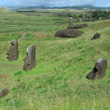 Moai stuck in the rock: On some places you can see clearly that some Moai were still being quarried. The statues have been laid bare from one side already, but are still attached to the crater on the other side. It therefore seems as though the local inhabitants stopped and left the quarry from one day to the next. Another theory is that some statues did not meet the quality demands, thus stopped with that particular statue and moved on to the next spot to start anew.
Moai stuck in the rock: On some places you can see clearly that some Moai were still being quarried. The statues have been laid bare from one side already, but are still attached to the crater on the other side. It therefore seems as though the local inhabitants stopped and left the quarry from one day to the next. Another theory is that some statues did not meet the quality demands, thus stopped with that particular statue and moved on to the next spot to start anew.
.
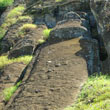 Moai Ko Tetu Kena – El Gigante: There are remarkably many statues till in the quarry varrying in height. 1 Moai in particular is worth mentioning, Ko Tetu Kena, with the knickname El Gigante, The Giant, which is almost twice the height of the largest finished Moai found on the island. If erected, El Gigante would stand up to 21.6m (64feet), weighing an estimated 270 tons, and is found on the outside of the crater caldera.
Moai Ko Tetu Kena – El Gigante: There are remarkably many statues till in the quarry varrying in height. 1 Moai in particular is worth mentioning, Ko Tetu Kena, with the knickname El Gigante, The Giant, which is almost twice the height of the largest finished Moai found on the island. If erected, El Gigante would stand up to 21.6m (64feet), weighing an estimated 270 tons, and is found on the outside of the crater caldera.
. .
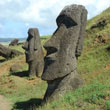 Moai sticking out of the ground: On the sides of the Ranu Raraku there are many burried ‘begraven’ Moai. On the one hand it seems as though they have sprung from seeds and are trying to grow towards the sun, like plants, yeet, on the other side it seems as though they are stuck in a swamp and are about to disappear further and further to their doom. These statues are not pulled over like the other ones on the coast, nor are most of them damaged; they are in very good condition, and are easily approachable, with the walking trail, the Road of the Moai, winding passed them. One of the theories is that they were lined up to be moved to their ‘new’ Ahu.
Moai sticking out of the ground: On the sides of the Ranu Raraku there are many burried ‘begraven’ Moai. On the one hand it seems as though they have sprung from seeds and are trying to grow towards the sun, like plants, yeet, on the other side it seems as though they are stuck in a swamp and are about to disappear further and further to their doom. These statues are not pulled over like the other ones on the coast, nor are most of them damaged; they are in very good condition, and are easily approachable, with the walking trail, the Road of the Moai, winding passed them. One of the theories is that they were lined up to be moved to their ‘new’ Ahu.
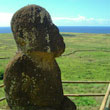 Moai Tukuturi: Moai Tukuturi at Rano Rakaku is very special find. Tukuturi has been sculpted from red scoria from Puna Pau rather than the locally found volcanic tuff. But what is especially surprising, is that it is a kneeling Moai, the only one found on the island. The statue is 3,7m tall, weighs about 10 tons, and its arms are ‘resting’ on its kneeling legs, also, he appears to have a goatee. In 1953 Tukuturi, was excavated, as it was almost completely burried..
Moai Tukuturi: Moai Tukuturi at Rano Rakaku is very special find. Tukuturi has been sculpted from red scoria from Puna Pau rather than the locally found volcanic tuff. But what is especially surprising, is that it is a kneeling Moai, the only one found on the island. The statue is 3,7m tall, weighs about 10 tons, and its arms are ‘resting’ on its kneeling legs, also, he appears to have a goatee. In 1953 Tukuturi, was excavated, as it was almost completely burried..
.
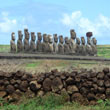 Ahu Tongariki: At the foot of the Rano Raraku is the impressive Ahu Tongariki. There are 15 restaured Moai standing on a 200m long platform, from different eras. The Ahu itself dates from about 690AD, and is thought to originally have been circular shaped, with about 30 Moai. It is known that the statues were already laying face down in 1770, but the damage has been greatest on May 20th 1960, when a tsunami destroyed the Ahu completely. Due to the 25m high wave the on average weighing 40 tons statues were moved up to 600m away. Between 1992 and 1996 the Ahu and the Moai were restaured by the Chilian governent and a Japanese firm. Behind the Ahu there are still some more Moai heads to be found, but it is not certain where they originally belonged. . .
Ahu Tongariki: At the foot of the Rano Raraku is the impressive Ahu Tongariki. There are 15 restaured Moai standing on a 200m long platform, from different eras. The Ahu itself dates from about 690AD, and is thought to originally have been circular shaped, with about 30 Moai. It is known that the statues were already laying face down in 1770, but the damage has been greatest on May 20th 1960, when a tsunami destroyed the Ahu completely. Due to the 25m high wave the on average weighing 40 tons statues were moved up to 600m away. Between 1992 and 1996 the Ahu and the Moai were restaured by the Chilian governent and a Japanese firm. Behind the Ahu there are still some more Moai heads to be found, but it is not certain where they originally belonged. . .

